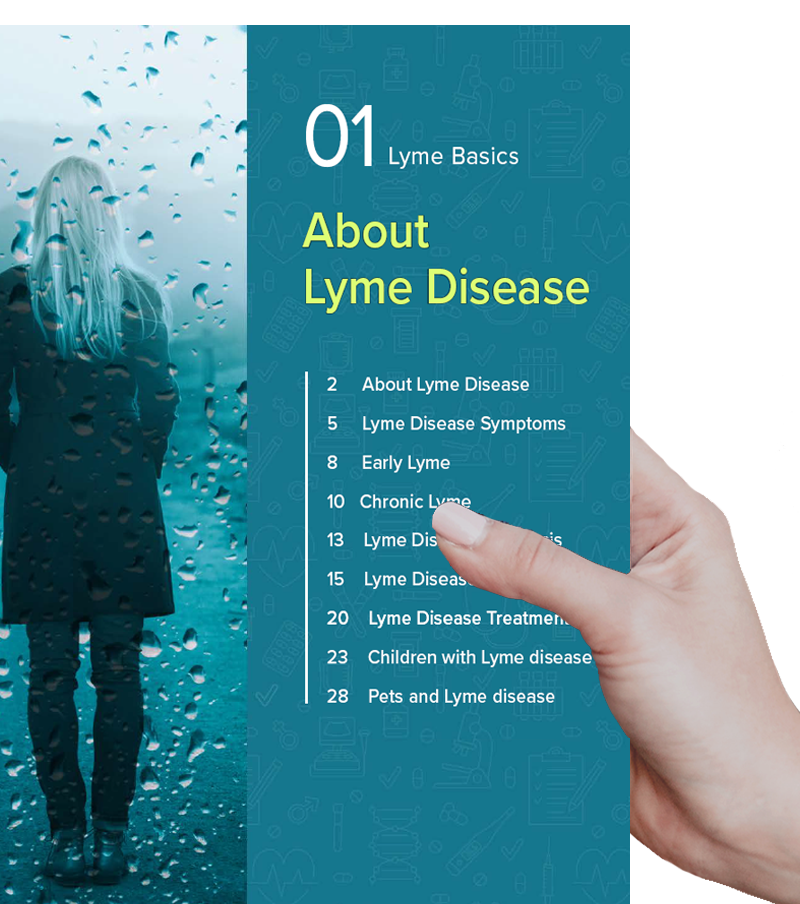Lyme Coinfections
Many people with Lyme disease also carry hidden Lyme coinfections that can intensify symptoms and delay recovery.

Ticks Can Transmit Multiple Lyme CoInfections
When you’ve been bitten by a tick, you can get more than just Lyme disease. Ticks can carry and transmit Borrelia burgdorferi, the bacteria that causes Lyme disease. But they can also transmit other infectious agents, including bacteria, viruses, or parasites. These are known as “Lyme co infections” or “co-infections.” Each one can have different symptoms and may require distinct treatment approaches. Some Lyme co infections, such as the Powassan virus, can be life-threatening if not treated promptly.
The most common Lyme co infections include Babesiosis, Bartonella, Ehrlichiosis, Mycoplasma, Rocky Mountain Spotted Fever, and Anaplasmosis. However, there are many others. The risk of encountering these infections depends not only on where you live, but more importantly, where you happen to be when a tick bites. Different tick species thrive in different environments and can carry a wide range of disease-causing organisms.
Borrelia miyamotoi
Borrelia miyamotoi is a bacterium that can cause tick-borne relapsing fever. It’s transmitted by the blacklegged (or deer) tick and typically presents with fever, chills, headache, fatigue, and muscle aches. Unlike other Lyme co infections, the fever often comes and goes in cycles, which can make it harder to recognize. And, B. miyamotoi can be transmitted in as little as 12 – 24 hours after the tick attaches.
Bourbon Virus
Bourbon virus is a rare tick-borne viral infection spread primarily by the lone star tick. It’s found mainly in the Midwest and southern U.S. The virus can cause fever, fatigue, headache, body aches, nausea, and sometimes a rash. Although uncommon, it can lead to serious complications and fatalities. There is no specific treatment, and testing is only available through the CDC.
Colorado Tick Fever
Colorado Tick Fever is a viral infection transmitted by Rocky Mountain wood ticks, found primarily in the western United States and Canada. It can cause fever, headache, muscle aches, fatigue, and sometimes a rash. There is no specific treatment, so care focuses on relieving symptoms and preventing further tick bites.
Heartland Virus
Heartland virus is a rare infection spread by the bite of an infected lone star tick. It can cause fever, fatigue, headache, muscle aches, nausea, and low blood cell counts. Most people experience mild symptoms, but serious illness can happen, especially in those with weakened immune systems. There is no specific treatment, so care focuses on relieving symptoms.
Mycoplasma
Mycoplasma are tiny bacteria that lack a cell wall, making them harder to detect and resistant to certain antibiotics. It is a common Lyme co infection. These bacteria invade human cells and disrupt the immune system, causing fatigue, musculoskeletal symptoms, and cognitive problems. Rarely, you can develop a rash, ranging from mild redness to painful blisters.
Powassan Virus
Powassan virus is a rare but serious tick-borne infection, transmitted by the blacklegged tick in the U.S. and the groundhog tick in parts of Canada. The virus can cause fever, headache, vomiting, weakness, confusion, and in severe cases, inflammation of the brain (encephalitis). However, some patients may not exhibit any symptoms.
What’s particularly concerning is that the virus can be transmitted within just 15 minutes to a few hours after a tick bite. There is no specific treatment, so care focuses on relieving symptoms, with hospitalization needed in more severe cases.
Q Fever
Q fever is a bacterial infection caused by Coxiella burnetii. It can be transmitted when someone breathes in dust or tiny droplets carrying the bacteria from infected animals such as sheep, goats, or cattle. In rare cases, it can also be spread by ticks. The brown dog tick, Rocky Mountain wood tick, lone star tick, and Pacific Coast tick can carry and transmit the bacteria.
The symptoms of Q fever are similar to those seen with other Lyme co infections. It often begins with a sudden high fever, and in some people, it may also cause pneumonia or affect liver function.
STARI (Southern Tick-Associated Rash Illness)
STARI is a tick-borne illness primarily found in the southeastern and south-central United States. It’s spread through the bite of the lone star tick. The exact cause of STARI is still not fully understood, but it is thought to be caused by a bacterium related to Lyme disease. Unlike Lyme disease, STARI is generally considered milder, and symptoms typically improve quickly with antibiotics or sometimes even without treatment.
Tick Paralysis
Tick paralysis is a rare but serious condition caused not by an infection, but by toxins released in tick saliva while the tick is attached and feeding. In the U.S., only the American dog tick and Rocky Mountain wood tick can cause tick paralysis. Once excreted, the toxin interferes with nerve function, leading to progressive paralysis. In most cases, the paralysis is reversed once the tick is removed.
Tick-borne Relapsing Fever
Tick-borne Relapsing Fever is an infection caused primarily by the bacteria Borrelia hermsii. It is spread by soft ticks (Ornithodoros hermsi) found in areas of the western U.S. Unlike blacklegged ticks that stay attached for days, soft ticks bite quickly — often at night — so many people never realize they’ve been bitten. The illness is marked by cycles of high fever that come and go, along with chills, headache, muscle aches, and fatigue.
Tularemia
Tularemia (or rabbit fever) is a rare but potentially serious infection caused by the bacterium Francisella tularensis. It can be transmitted through the bite of dog ticks, lone star ticks, and wood ticks, as well as through contact with infected animals or inhaling contaminated dust. Symptoms may include skin ulcers, swollen and painful lymph glands, inflamed eyes, sore throat, mouth sores, pneumonia, diarrhea and vomiting.
Note: The information presented on this page has been reviewed and approved by a member of our Medical Leadership Board.

Take Our Quiz
Answer a few questions to find out if you might benefit from testing with the Autoimmune Brain Panel™.
Take the first step towards understanding tick-borne disease with an exclusive guide to something here, all backed by world-leading science.

More Lyme Basics
Learn More
Ticks are tiny parasites that feed on the blood of their hosts (humans and animals) in order to survive and advance to the next life cycle stage. Most ticks have four stages: egg, larva, nymph and adult. The larva and nymph need a blood meal to move to the next stage. Ticks are extremely small, with the nymph the size of a pinhead.
Learn More
Learn More




